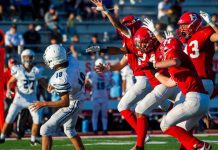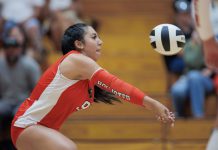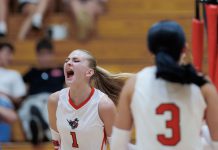Synthetic turf has improved by leaps and bounds in recent
years
… here’s how
Fans of three local high schools’ sports teams have had plenty of opportunity to gaze with admiration at synthetic turf fields in recent years. Football teams from Gilroy High and San Benito High have played several section playoff football games on the artificial surface at San Jose City College, and competed in regular season games at high schools such as Valley Christian and Salinas with artificial playing surfaces. Live Oak High’s football team played a regular season contest on Alisal’s synthetic turf this fall, and the Acorn girls soccer team competed in section playoff matches on fake turf at Milpitas and Valley Christian.
Simply put, most local high schools’ sports teams are logging plenty of time on the stuff these days as the number of schools in the Bay Area with synthetic turf fields multiplies exponentially.
Take one look at an immaculate artificial turf field and it’s easy to see why they’re becoming so popular. Look even closer and it’s even easier to see why technology has made them all the rage.
Instead of the old sticky carpet over concrete that contributed to so many blown-out knees and concussions, today’s synthetic turf is built for safety and durability.
Manufactured by companies like FieldTurf and SprintTurf, and sold and installed by regional representatives, synthetic turf includes a surface of thousands of blades of polyethylene “grass” supported by a mixture of sand and granulated rubber (or just rubber in the case of SprintTurf) to simulate the feel of natural grass and dirt.
Not only are the surfaces highly weather-resistant and relatively low-maintenance – requiring no watering or lining, and minimal upkeep compared to natural grass fields – but they are also generally regarded as much safer than previous artificial surfaces because of their flexibility. Some proponents even claim synthetic turf can be safer than natural grass fields, which are rarely level and can be pockmarked with patchy grass, sinkholes and divots.
The new surfaces are capable of accomodating a range of uses throughout the year that natural grass fields, with their vulnerability to wear and weather, can not.
Meanwhile, in just the past few years, the cost of synthetic turf has dipped from about $1 million to about $600,000 per installation. And, since the turf requires so little upkeep, schools can ostensibly defray the additional initial cost of installation by saving on maintenance costs.
With all these factors, it’s little surprise that so many Bay Area high schools are customers. In San Jose, they range from Valley Christian, a private school that was one of the first in the area to install synthetic turf, to most of the 16 schools in the San Jose Unified School District and the East Side Union High School District to most of the Salinas-area high schools.
At Milpitas, which installed synthetic turf on its football, baseball and softball fields last year as part of a multi-million dollar upgrade project, Athletic Director Jeff Lamb said the surfaces have been a major success. Lamb said Milpitas’ old sports fields were disasters because of the lack of funding available for regular upkeep and maintenance.
“We can use these fields 24-7, and we don’t have to worry about upkeep,” he said. “Our fields were in terrible shape (before synthetic turf), and the grass field we put in at about the same time (as the synthetic turf) is already in bad shape.”
Valley Christian, which installed synthetic turf on its football, soccer, baseball and softball fields about four years ago, was one of the first area schools to try the new surfaces. Athletic Director Eric Scharrenberg said the fields have been an unqualified success. In fact, Scharrenberg said there has actually been a decrease in the number of sports-related injuries since synthetic turf was installed.
“I don’t know if it’s because the field is level or if it’s because feet don’t get stuck,” Scharrenberg said. “I don’t have actual numbers available that say there are fewer injuries but it definitely feels like a lot less.”
Usability and cost
Durability and versatility are generally the biggest selling points in favor of synthetic turf. Because it is so weather-resistant, schools’ football and soccer teams can use the turf fields for both play and practice without incurring the damage associated with similar use on vulnerable natural grass fields.
In addition, because the turf is so durable, schools can open them up to use by other groups, including youth and adult football and soccer, field hockey, rugby, band, ROTC, and the like.
And, because the turf is so aesthetically attractive, schools that put in the stuff often find themselves transformed into the popular spot to hold special sporting events, such as multiple section playoff football games or large soccer tournaments.
Meanwhile, most school officials say synthetic turf, though costly to install, combines increased usability with vast reductions in upkeep and maintenance costs. While natural grass can cost as much as $30,000 to $60,000 per year to water, stripe, mow, re-seed, and re-sod, synthetic turf requires a fraction of the cost to maintain.
Perhaps the biggest potential drawback to installing a synthetic turf field is the cost of replacing or repairing the surface, which can be costly. A standard warranty lasts about eight to 10 years, and most fields are projected to last about 12 to 15 years before any major maintenance work needs to be done. But the technology is so new that most of the newer synthetic turf fields haven’t reached those milestones yet.
FieldTurf and SprintTurf representatives say their surfaces will probably need to be replaced or repaired in sections, focusing on high-use areas, rather than in their entirety. Even if the entire surface has to be replaced, turf reps say the cost is likely to be about half the cost of the initial installation because the substrata, including the drainage and cooling systems, are expected to outlast the surface itself.
Safter than ever
Then there is the relative safety of synthetic turf fields compared to natural grass.
In the days of Astroturf, which was also valued for its durability and cost efficiency, athletes showed a remarkable tendency to suffer devastating knee, ankle and toe injuries (ACL tears and “turf toe”) as their shoes “stuck” in the carpet and left them vulnerable to contact. Concussions were also a problem, caused by landing head-first on the carpet-covered concrete base. In fact, in just the past decade, many pro and college sports teams began replacing their old-style artificial turf with natural grass as a result of the flood of injuries associated with the stuff.
But studies have shown that the new generation of artificial turf, with its softer base and cushioned surface, is much safer than the old Astroturf and could actually be safer in some important ways than natural grass.
According to a study published in the American Journal of Sports Medicine, there are similarities between the incidence, causes and severity of sports-related injuries on both synthetic turf and natural grass. But there are also significant differences. For instance, the study found that while synthetic turf was associated with a higher incidence of skin injuries, such as abrasions and burns, and muscle strains and spasms, natural grass actually had a higher incidence of concussions and ligament tears.
Interestingly, the study also found a higher incidence of injury on synthetic turf at higher temperatures (70 degrees or above) than on natural grass.
According to physical therapist Rob Conlan of St. Louise Regional Hospital’s out-patient service provider Fritter, Schultz and Conlan, the new synthetic turf seems generally safer. Conlan said he has watched plenty of Morgan Hill Raiders Pop Warner football games on the new artificial surface in San Jose.
“It’s so soft and it gives way,” Conlan said. “Kids can bounce right off it and get right back up. I think the incidence of injuries will go down. It’s almost softer than natural grass.”
In just the past few years, synthetic turf has made major strides and most believe it will continue to develop. If it continues to spread, before long it could eclipse natural grass as the most popular sports surface at every level of athletic competition.









